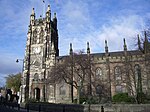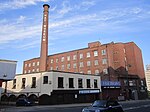
Stockport is a town in Greater Manchester, England, 8 miles (13 km) south-east of Manchester, 9 miles (14 km) south-west of Ashton-under-Lyne and 12 miles (19 km) north of Macclesfield. The Rivers Goyt and Tame merge to create the River Mersey here. It is the main settlement of the wider Metropolitan Borough of Stockport.
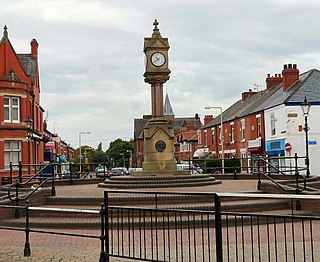
Reddish is an area in Metropolitan Borough of Stockport, Greater Manchester, England. 4.6 miles (7.4 km) south-east of Manchester city centre. At the 2011 census, the population was 28,052. Historically part of Lancashire, Reddish grew rapidly in the Industrial Revolution and still retains landmarks from that period, such as Houldsworth Mill, a former textile mill.

St Ann's Church is a Church of England parish church in Manchester, England. Although named after St Anne, it also pays tribute to the patron of the church, Ann, Lady Bland. St Ann's Church is a Grade I listed building.

The Cathedral Church of St. John the Evangelist, usually known as Salford Cathedral, is a Catholic cathedral on Chapel Street in Salford, Greater Manchester, England. It is the seat of the Bishop of Salford and mother church of the Diocese of Salford, and is a Grade II* listed building.
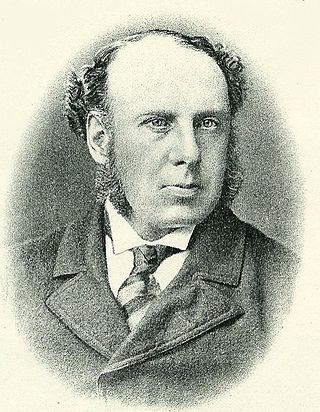
Sir William Henry Houldsworth, 1st Baronet was a British mill-owner in Reddish, Lancashire. He was Conservative MP for Manchester North West from 1883 to 1906, and sometime chairman of the Fine Cotton Spinners' Association. He was made a baronet in 1887.

Stockport Town Hall is a building in Stockport, Greater Manchester, England, that houses the government and administrative functions of Stockport Metropolitan Borough Council. Stockport Town Hall is a Grade II* listed building.

St Mary's Church is the oldest parish church in the town of Stockport, Greater Manchester, England. It stands in Churchgate overlooking the market place. The church is recorded in the National Heritage List for England as a designated Grade I listed building. It is an active Anglican parish church in the diocese of Chester, the archdeaconry of Macclesfield and the deanery of Stockport.

St Thomas' Church is in St Thomas's Place, Wellington Road South, Stockport, Greater Manchester, England. It is an active Church of England church in the parish of Stockport and Brinnington, in the deanery of Stockport, the archdeaconry of Macclesfield, and the diocese of Chester. The church is recorded in the National Heritage List for England as a designated Grade I listed building. It was a Commissioners' church, having received a grant towards its construction from the Church Building Commission.

Houldsworth Mill, also known as Reddish Mill, is a former mill in Reddish, Stockport, Greater Manchester, England. Designed by Abraham Stott, it was constructed in 1865 for Henry Houldsworth, a prominent mill owner at the time. It is a Grade II* listed building.
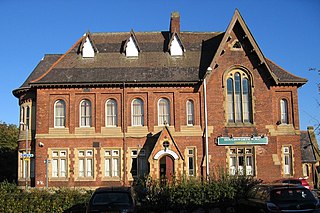
Houldsworth Working Men's Club is a club in Stockport, Greater Manchester, England. Designed by the famed Alfred Waterhouse and completed in the late 19th century, it is still used as a working men's club today. An important local structure, it is now a Grade II* listed building.

Greater Manchester is a metropolitan county in North West England. It was created by the Local Government Act 1972, and consists of the metropolitan boroughs of Bolton, Bury, Oldham, Rochdale, Stockport, Tameside, Trafford, Wigan and the cities of Manchester and Salford. This is a complete list of the Grade I listed churches in the metropolitan county as recorded in the National Heritage List for England. Buildings are listed by the Secretary of State for Culture, Media and Sport on the recommendation of English Heritage. Grade I listed buildings are defined as being of "exceptional interest, sometimes considered to be internationally important"; only 2.5 per cent of listed buildings are included in this grade.

Sacred Heart Church is a Grade II listed redundant Roman Catholic church on Tyldesley Road, Hindsford, Atherton in Greater Manchester, England. It has been designated by English Heritage as a Grade II listed building.

There are 48 Grade I listed buildings in Greater Manchester, England. In the United Kingdom, the term listed building refers to a building or other structure officially designated as being of special architectural, historical or cultural significance; Grade I structures are those considered to be "buildings of exceptional interest". In England, the authority for listing under the Planning Act 1990 rests with Historic England, a non-departmental public body sponsored by the Department for Culture, Media and Sport.
Houldsworth Model Village was a model village situated in the centre of Reddish, 3 miles north of Stockport in the North of England. It was built by William Houldsworth, for the benefit of his employees at Houldsworth Mills.
Stockport is a town in the Metropolitan Borough of Stockport, Greater Manchester, England. The town, including the areas of Heaton Moor, Heaton Mersey, Heaton Chapel, and Reddish, contains 139 listed buildings that are recorded in the National Heritage List for England. Of these, four are listed at Grade I, the highest of the three grades, 16 are at Grade II*, the middle grade, and the others are at Grade II, the lowest grade.
Denton is a town in Tameside, Greater Manchester, England. The town and the township of Haughton contain 18 listed buildings that are recorded in the National Heritage List for England. Of these, one is listed at Grade I, the highest of the three grades, three are at Grade II*, the middle grade, and the others are at Grade II, the lowest grade.
Manchester is a city in Northwest England. The M11 postcode area of the city includes the suburb of Clayton. This postcode area contains 15 listed buildings that are recorded in the National Heritage List for England. Of these, two are listed at Grade II*, the middle of the three grades, and the others are at Grade II, the lowest grade. Most of the listed buildings in the area are associated with the Ashton Canal, which runs through it; these consists of locks, bridges, and a lock keeper's cottage. The other listed buildings are a former manor house, a bridge in the grounds of the manor house, two churches, and a school.
Manchester is a city in Northwest England. The M22 postcode area of the city includes parts of the suburbs of Northenden and Wythenshawe. This postcode area contains 15 listed buildings that are recorded in the National Heritage List for England. Of these, three are listed at Grade II*, the middle of the three grades, and the others are at Grade II, the lowest grade. The area is largely residential and most of the listed buildings are houses and churches and associated structures. The other listed buildings include a bridge, a war memorial, and a former bus depot.
















